You are probably aware that there are a lot of different types of Italian breads. But do you really know about them? There are few varieties alike, from shapes to sizes and colors to flavors. Learning about those differences is essential if you want to enjoy Italian breads properly.
That is where this post will come in handy. Continue to read and join me on this journey to discover various delicious treats from Italian cuisine. You’ll be amazed by what Italian bread, with its thousands of years of history, has to offer.
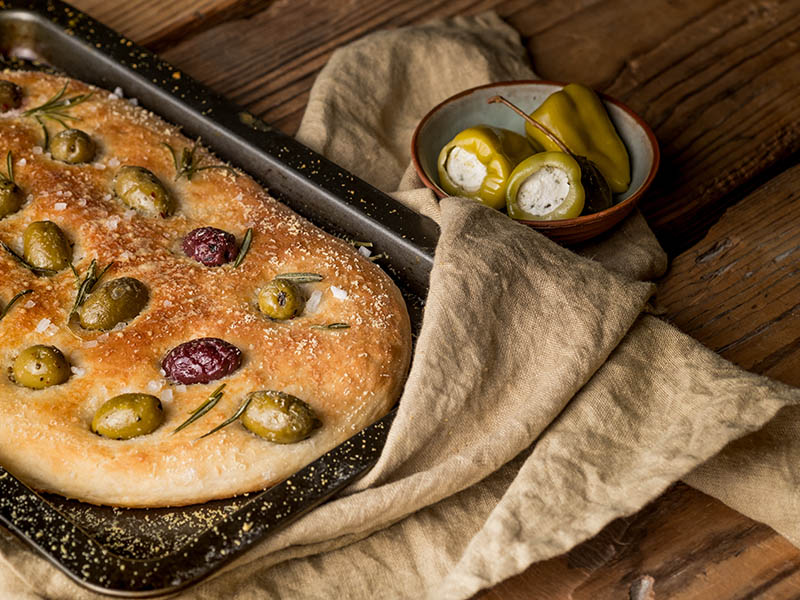
These Yummy Italian Breads Will Win You Over
From the chilly north to the balmy south of Italy, you can always find savory bread varieties begging for you to enjoy them. Some are more famous than others, but you can guarantee that even little-known breads will give you a real treat.
1. Focaccia
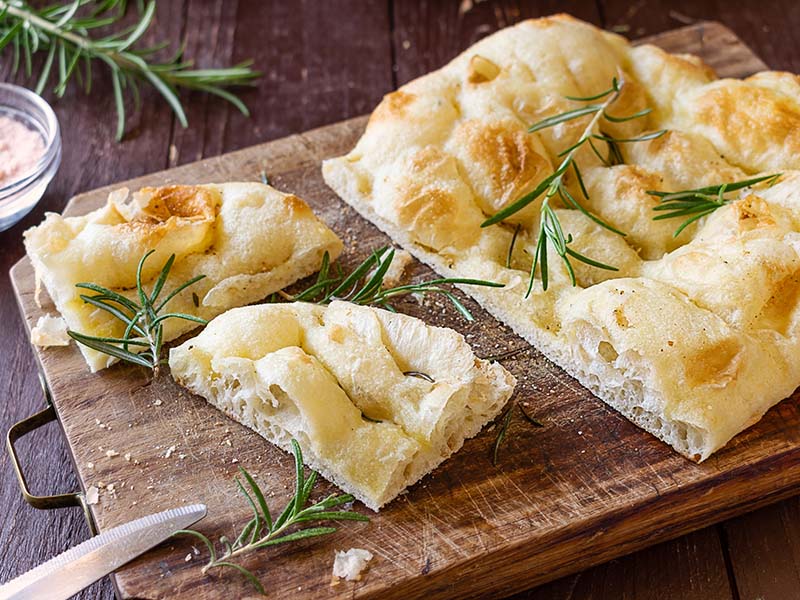
Origin: Italy
Let’s start with the most beloved baked bread in Italy: Focaccia, whose name is derived from a Latin word for “hearth”. The bread got that name because ancient Romans baked it on their hearth. Nowadays, oven-baked Focaccia is more convenient but less tasty than the old method.
Before becoming Italy’s national bread, Focaccia originated in Liguria (in northwest Italy). This flatbread consists of semolina, wheat flour, yeast, and potatoes. It is highly similar to pizza dough. But people bake pizza immediately after flattening it while Focaccia is allowed to rise.
You can serve Focaccia plain or with toppings. In its pure form, the bread has a pleasantly yeasty smell accompanied by a crisp exterior and a soft, chewy interior.
You can top the bread with herbs and drizzle olive oil over or enjoy it with soups for a more complex flavor.
Check out disparate varieties of Focaccia here.
2. Michetta

Origin: Lombardy region
Also known as Rosetta (literally “little rose”) in many parts of Italy, this Italian white bread can easily leave a lasting impression with its distinct bulged shape. It first appeared in Lombard around the 19th century when the region was part of the Austrian Empire.
Naturally, Michetta drew inspiration from the Austrian bread Kaisersemmel. As time went by, the Italian bread developed its discrete characteristics. For example, it is highly leavened, hollow, and airy on the inside but tantalizingly crunchy on the outside.
While Michetta means “little crumbs”, this bread is more like a sweet blend of donut and bread. A Michetta, ham, cheese, and avocado combo represents a quick and delicious Italian meal.
3. Ciabatta
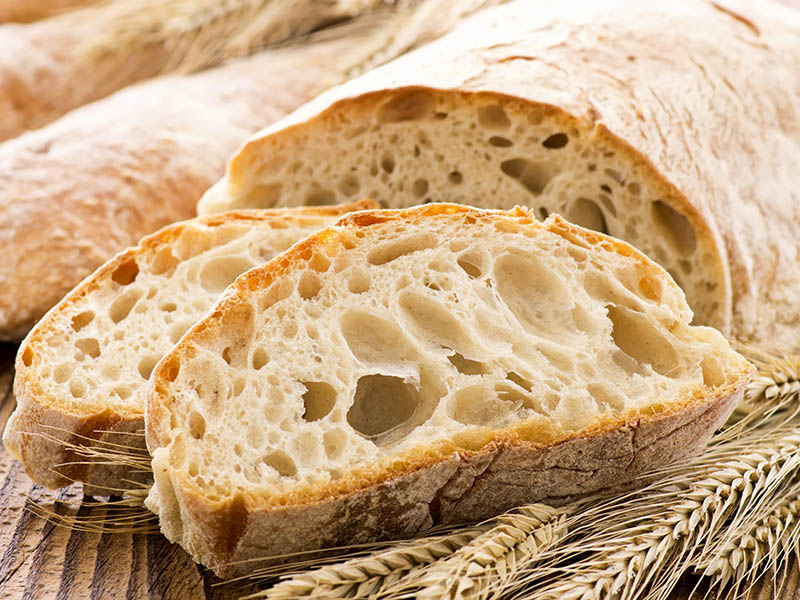
Origin: Veneto region
Compared to other Italian breads that have existed for centuries or millennia, Ciabatta is a young upstart. It was created in 1982 by an Italian miller who initially called it Ciabatta Polesana after Polesine, the area in northeastern Italy where he lived.
What makes this white bread tasty enough to contend with other giants of Italian baked goods? The appeal lies in the bread’s strong flour and very wet dough, which results in a savorier bread. Also, Ciabatta is baked with a high hydration level, creating extra holes on its surface.
The original purpose of Ciabatta was to compete with the French baguettes that, in the 1980s, flooded the Italian market. It has performed more admirably than anyone could envision. Today, Ciabatta is one of the most prevalent breads that you can order in Italy.
4. Pizza Bianca
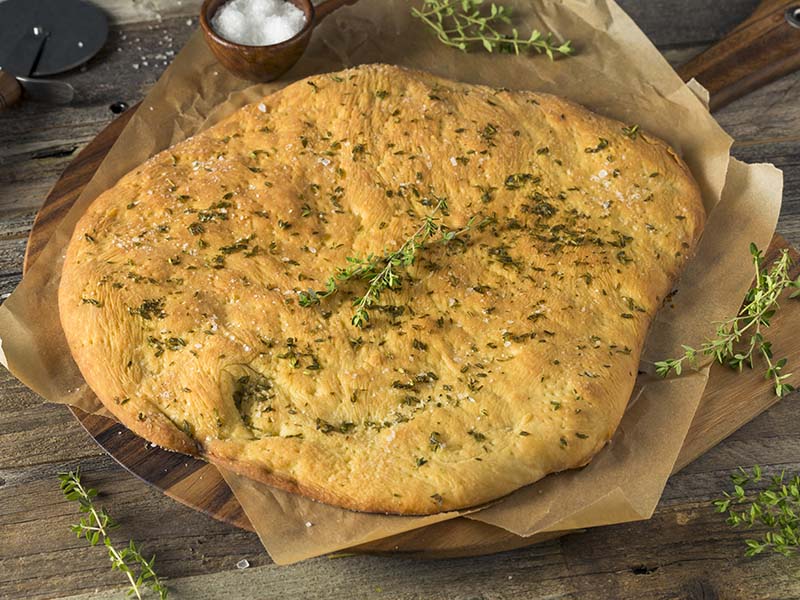
Origin: Italy
What is your favorite Italian snack? Nothing can deliver Italian cuisine’s fresh and organic nature more than a pizza. But not just any kind; I’m talking about Pizza Bianca (“white pizza”).
True to its name, this distinct type of bread doesn’t use the iconic tomato sauce. Besides its crisp, dry, and chewy pizza dough, Pizza Bianca only comes with garlic, cheese (usually Ricotta), herbs, and veggie toppings.
Wait, no olive oil? Actually, this Italian bread contains considerably less olive oil than other pizzas, contributing to its leaner taste. But when you order Pizza Bianca in a restaurant, people will usually give you an accompanying olive oil-based sauce to enrich your pizza to your liking.
There is more than one way to cook Pizza Bianca. Discover all of them here.
5. Pane di Segale
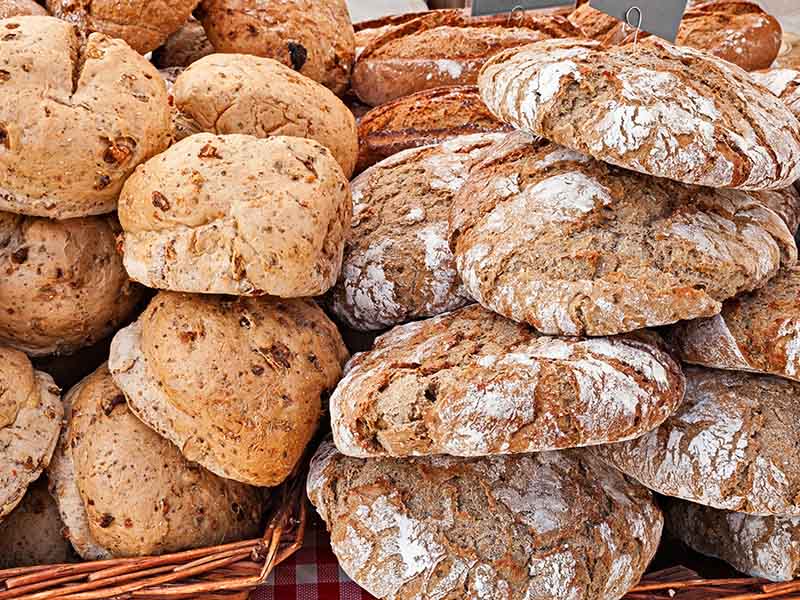
Origin: Italy
This fancy name simply means “rye bread” in Italian. Since rye is a nutritious, fiber-rich, and nutrient-loaded grain, its baked goods can provide you with numerous health benefits. Rye bread will delight you with its denser texture and a more complex, earthlier taste.
The Italian version is different from varieties of rye bread elsewhere, thanks to the use of caraway and fennel seeds. Those spices give the bread its pleasingly nutty and bittersweet taste.
Also, Pane di Segale is lighter in color and comes with a softer crust suitable for slicing and cutting. If you want to add extra nutrients to your menu, this Italian bread will show you how.
6. Ciriola
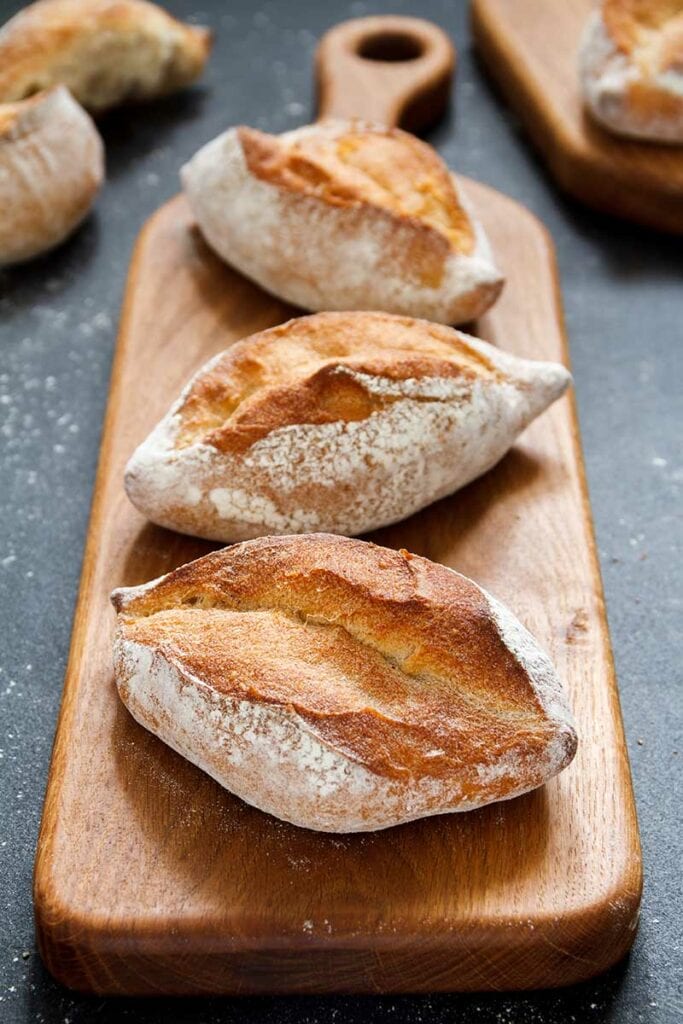
Origin: Lazio region
What does the shape of Ciriola remind you of? Do you think that it looks like a candle flame? That’s probably what the Italians think because they name this bread “candle” in Italian.
However, another theory, perhaps a little far-fetched, says that Ciriola is derived from “ciriole” (European eels). This endangered animal once swam in abundance around the region of Lazio, the birthplace of Ciriola. The elongated form of the bread looks like an eel, hence the name.
Ciriola is extremely affordable since it is made from basic ingredients such as yeast-raised white flour, olive oil, and seasonings.
Therefore, it is a favorite dish for the Italian working class. You can follow this local example and enjoy a toasted Ciriola with toppings (this is called Crostini, a great Italian starter). When Ciriola is soft, it can be stuffed with meats, cheese, and veggies to create a Panino.
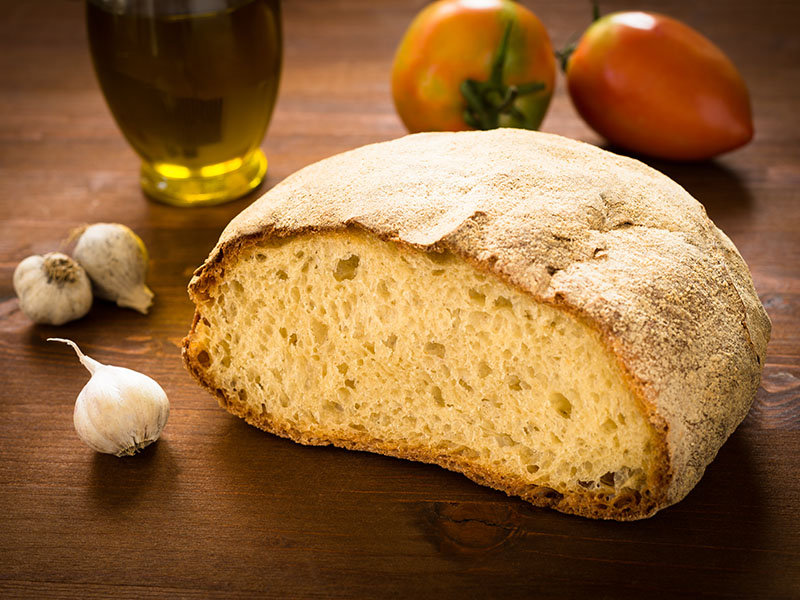
7. Pagnotta
Origin: Umbria-Abruzzi region
Pagnotta is an Italian round bread that you can find in many parts of the country, not least in the central region around Umbria-Abruzzi. Like other delightful breads from the boot-shaped land, Pagnotta has a soft and spongy interior encased by a crisp, deep-brown crust.
The rustic root of this bread is evident in its simple, easy-to-gather ingredients. Just get some flour, yeast, and olive oil, and you’re good to go. However, creating the best Pagnotta requires a little time and skill. This countryside bread goes well with soup, sausages, or pasta sauces.
8. Filone
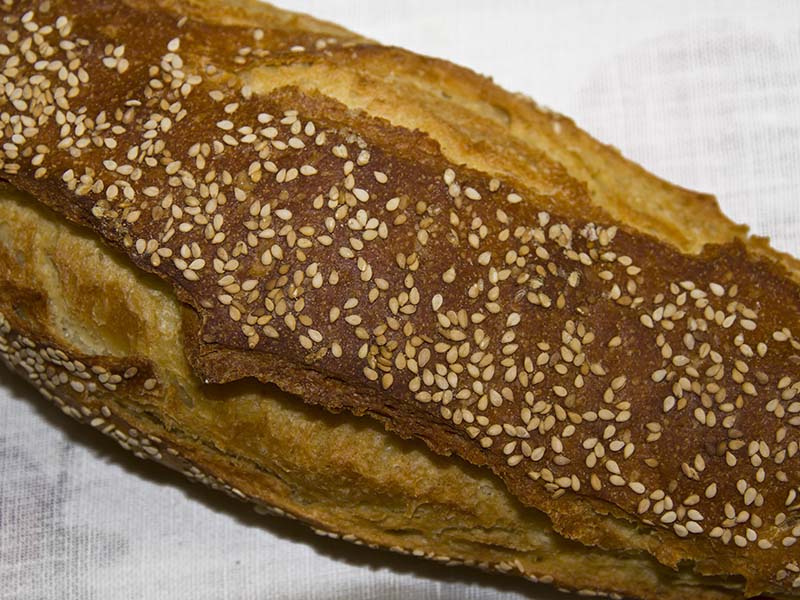
Origin: Calabria and Tuscany regions
While this Italian equivalent of baguette originated in Calabria and Tuscany, you will find it anywhere you travel in Italy. Its name stems from the Italian word “filo”, meaning line. That name suits the long, narrow form of this hard-outside, soft-inside bread.
The main ingredients for Filone are comparable to those for baguettes: all-purpose flour, dry yeast, and salt. However, Filone can be prepared with a sourdough starter and brushed with roasted sesame seeds for a more robust and nuttier flavor.
9. Friselle

Origin: Apulia region
A glance at the ingredients that form Friselle won’t impress you much. They are just plain durum flour, yeast, and water.
However, come back when this bread is doubled baked to perfection and served with fresh tomatoes as well as olive oil. You will be overwhelmed by its glory.
Friselle is easily recognizable thanks to its beautiful round shape with a hole in the middle, like a flat bagel. Before serving, people have to bake this bread twice and soak it in saltwater or spring water, giving it a distinct grainy sweetness mingled with tanginess.
10th-century Apulia seems to be the birthplace of Friselle. The bread started as food for farmers or fishermen working far from home, so local inhabitants prepared it carefully to keep it fresh for a long time. Today, that quality is still a much-appreciated virtue.
This thorough tutorial will help you create the best homemade Friselle.
10. Grissini
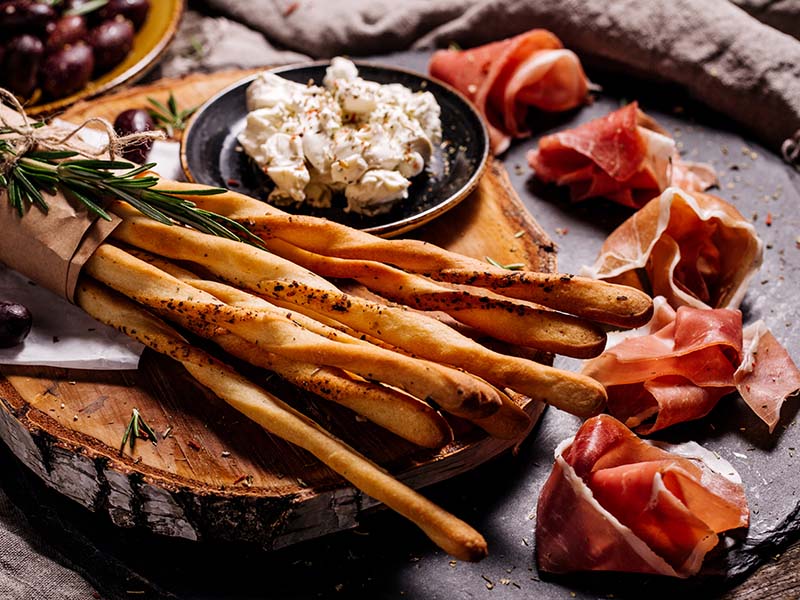
Origin: Piedmont region
If you love the buttered breadsticks bought at the local supermarket, you have the Italians to thank for it. Known in Italy as Grissini, the breadstick is a fantastic Italian delight. However, its history is hazy, not due to the lack of information, but because there is too much of it.
One theory says that Grissini first appeared around the mid-17th century in Lanzo Torinese, a commune in the Piedmont region. However, another one attributes this pencil-sized, savory, amber bread to a Turin baker who devised it for the Duke of Savoy.
The bread is available in both soft and crisp forms to pair with superb Italian cheese, cured meat, or olives in Italy. But outside the country, Grissini is mainly a soft appetizer or dessert that foodies love to top with butter, cinnamon, or cheese. So what style are you going to choose?
11. Ciambella
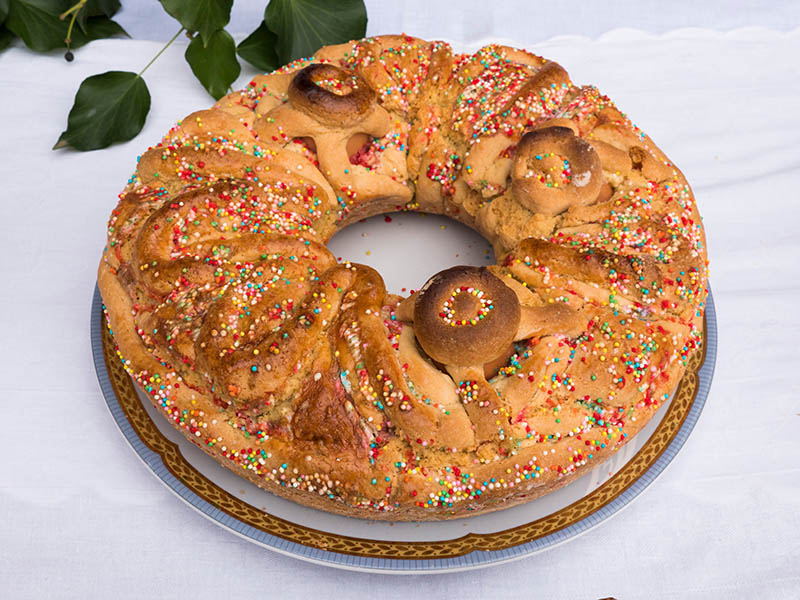
Origin: Emilia Romagna region
While this braided bread looks like a bundt cake, it is a traditional Italian recipe that nonnas (grandmothers) have long treasured for their beloved children. The name Ciambella refers to all kinds of ring-shaped baked goods that you can find in every corner of Italy.
The making of this bread calls for flour, milk, baking powder, and flavorings such as honey or chocolate. Also necessary is a bundt pan which you have to bake the dough with to give Ciambella its unique shape.
Ciambella is a fragrant and delicious treat with a crisp crust and a spongy inside. There is an Italian proverb with it that says “Non tutte le ciambelle riescono col buco”. It literally means “not all Ciambella has a hole” or, figuratively, “not everything turns out as planned”.
12. Pandoro
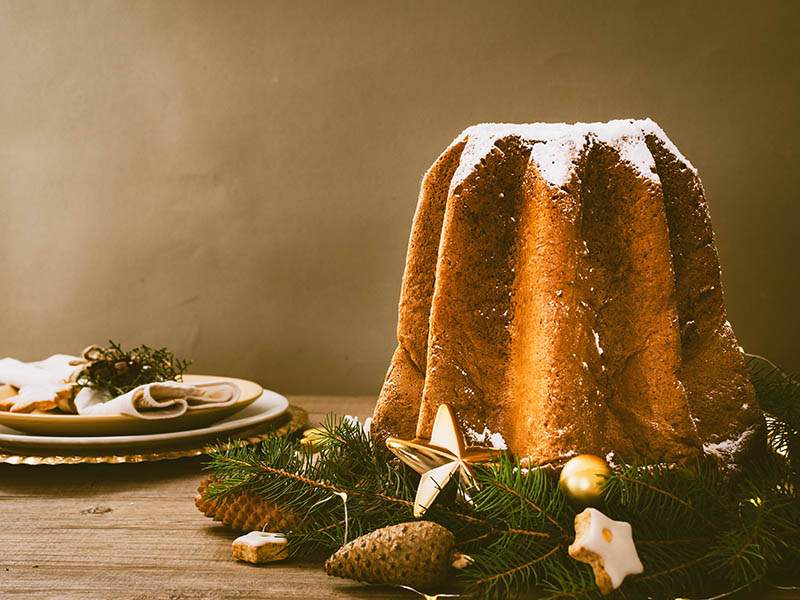
Origin: Veneto region
You should try this traditional sweet bread if you plan to spend a winter holiday in Italy. Christmas and New Year parties would be less festive without a beautiful, vanilla-flavored Pandoro on the table.
Pandoro dates back to the Middle Ages when only the wealthy could afford it. Back then, the main ingredients for Pandoro, such as cream, butter, milk, and sugar, weren’t something that ordinary people could comfortably get their hands on.
Luckily, that isn’t the case nowadays. Shaped like a pretty eight-pointed star and bathed in mouth-watering icings from honey to chocolate, Pandoro is ready to delight both your eyes and your taste buds.
This bread is a common sight throughout Italy, but the northern part of the country is allegedly its birthplace. Pandoro means “golden bread” in Italian. Have a taste of this decadent, savory treat in the chilly air, and you’re golden!
It is effortless to make Pandoro when you have this in-depth guide.
13. Pane di Pasqua

Origin: Italy
If the Easter bunny arose from Italians instead of the German immigrants settling in America, we would probably have Pane di Pasqua alongside Easter eggs. Pane di Pasqua is a traditional Italian braided bread popular during Easter, especially in northern Italy.
Anyway, a dish of Pane di Pasqua adorned with colorfully dyed eggs forms the mainstay of any Easter menu in Italy. It is a festive sight that can raise the spirits of children and adults alike.
Italians prepare Pane di Pasqua from a mixture of flour, butter, milk, and eggs. It has a pleasingly tender texture and a creamy deliciousness if enjoyed as soon as it is made.
While the dyed eggs are for decorative purposes, there is nothing wrong with slicing them and using them for salads.
14. Colomba di Pasqua
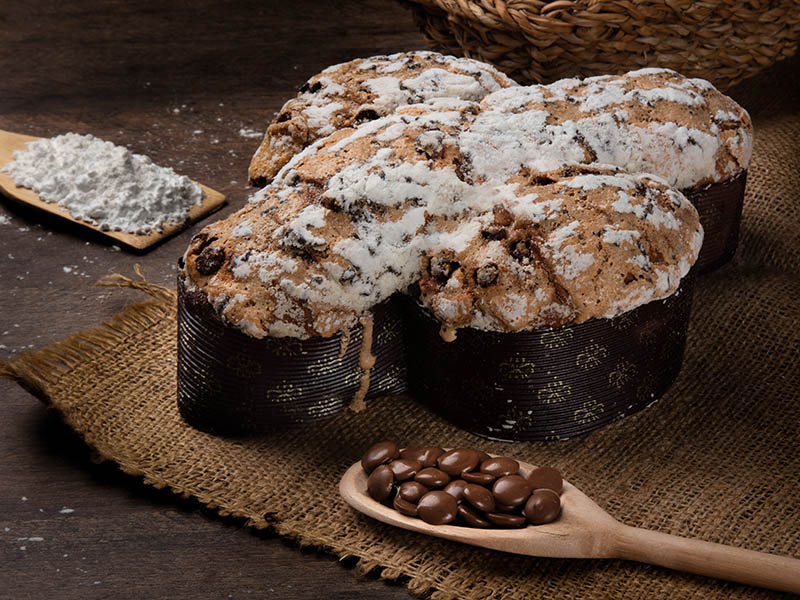
Origin: Umbria region
Pane di Pasqua isn’t the only delight for Easter in Italy since there are numerous other choices. For example, the Umbria region in central Italy has a cheese bread called Cresia for the occasion. But it is a regional specialty, unlike Colomba di Pasqua which has a national appeal.
By definition, Colomba di Pasqua is a sweet, nutty, and aromatic combination of flour, eggs, pearl sugar, almond, and orange extract. Since the name means “Easter dove” in Italian, the bread is understandably molded after the shape of that bird.
This bread is so ancient that it possesses many origin stories. One famous legend says that when the Lombard king Alboin conquered Pavia in 572, a clever local maiden created it in the image of the symbol of peace to appeal to his better nature.
In the end, the king accepted it, spared the city, and even made Pavia his capital. That sounds a little too good to be true. But in a weary world troubled by wars and conflicts, I guess everyone needs a miracle to hang on to. And it helps if that miracle is as delicious as Colomba di Pasqua.
15. Panettone
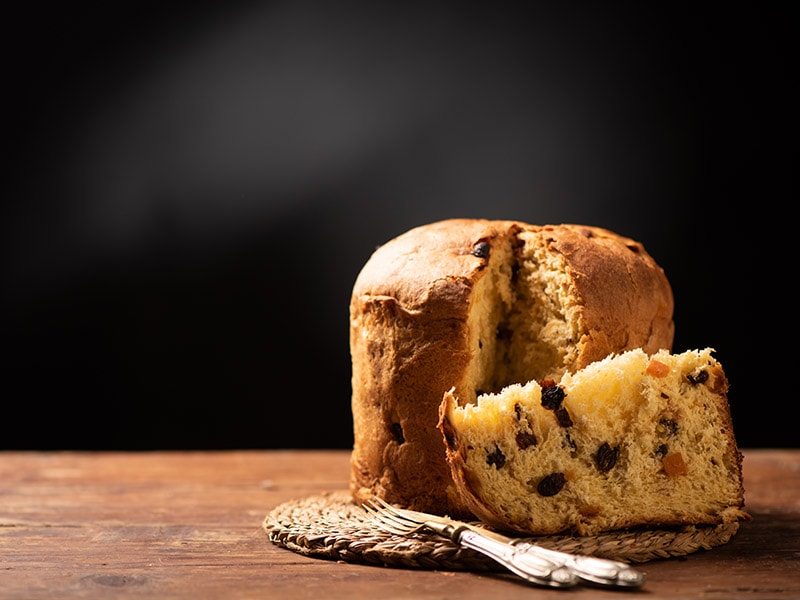
Origin: Lombardy region
Among the most well-known Italian desserts, Panettone is the pinnacle of how enticing Italian cuisine can be. Don’t feel bad if you mistake it for a cake instead of the finger-licking sweet bread it is; everybody falls for that.
Originally a Milan specialty, Panettone is now an indispensable pleasure for Christmas and New Year holidays in Italy, Europe, and even South America. Why South America? The bread followed the Italian immigrants who moved to those countries from the 17th to the 20th centuries.
A typical Panettone can weigh up to 1 kilogram. Inside this big mass is an ocean of deliciousness. Once you bite a soft, airy piece of this Christmas delight, you will feel its fragrant candied fruits, nutty almonds, tangy orange peel, and sweet, buttery flour.
This bread usually has a cylindrical shape and can rise to between 12 and 15 centimeters in height. It takes a little longer than other baked goods to prepare, which drives up its cost. But the saving grace is that you can turn its leftovers into a delicious bread pudding.
Check out how people make traditional Panettone in Italy.
16. Cornetto
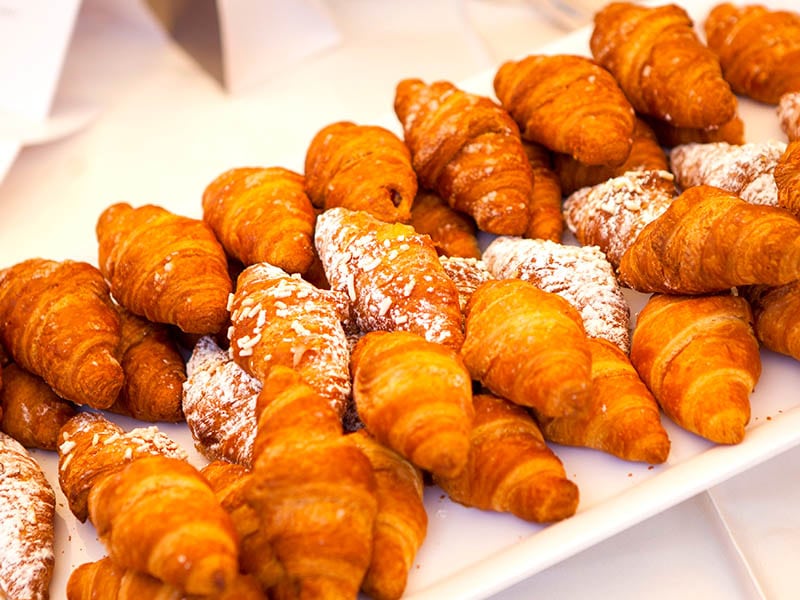
Origin: Italy
If you think Cornetto is the name of an Italian ice cream brand, you’re not alone. Suppose that you look at the actual Cornetto bread and mistake it for a French croissant; that is no big deal. But it is unforgivable if you sink your teeth into it and fail to realize its sumptuousness.
Contrary to what you may think, Cornetto isn’t an imitation of French breads. Instead, it drew inspiration from an Austrian yeast bread called Kifli (or Kipfel). Somewhere after the 17th century, ingenious chefs in Venice turned Kifli into the Italian delight Cornetto.
Cornetto is perfect for people who prefer a less greasy version of croissants. The main reason is that this bread doesn’t contain as much butter.
In addition, it can come with various flavorful fillings, such as fruit jams or chocolate cream. A cup of robust Italian coffee will bring out its delicate taste.
17. Focaccia Barese
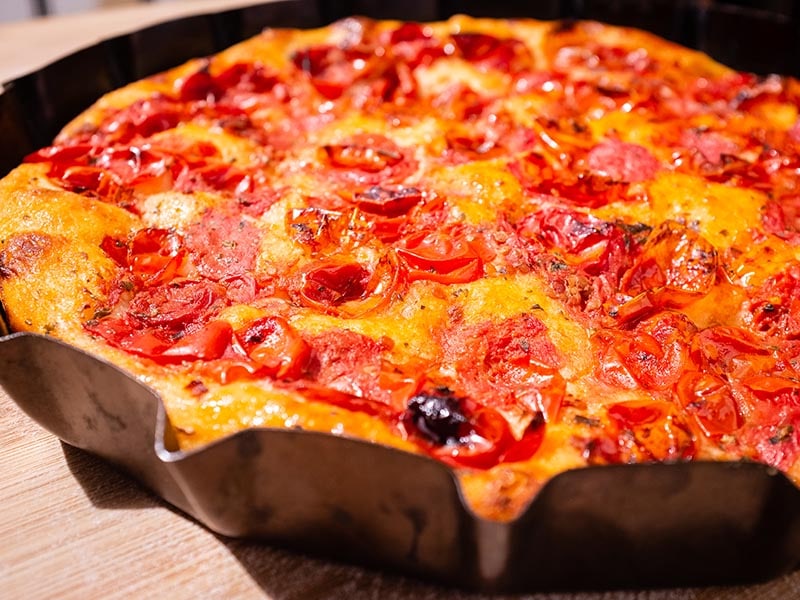
Origin: Apulia region
As suggested by the name, this one is the version of Focaccia from the province of Bari in southeastern Italy. But the appeal of Focaccia Barese doesn’t stop there.
It is a favorite snack, a beloved picnic item, and a side dish with soups in the Puglia region, the Italian name for Apulia.
Bari is well-known for many fantastic wonders, from its historic harbor to tempting golden sand beaches. And a piece of Focaccia Barese is the icing on the cake.
What distinguishes this regional variety from mainstream Focaccia is the inclusion of durum wheat flour and mashed potatoes. Accompanying this flavorful dough is a finger-licking topping of ripe tomatoes, olive oil, and herbs like oregano.
Besides Focaccia Barese, various types of this bread from other regions of Italy also deserve your attention. Schiacciata from Tuscany has attractive dimples, while Focaccia Ligure from Liguria is blissfully teeming with olive oil and cheese.
18. Pane di Altamura
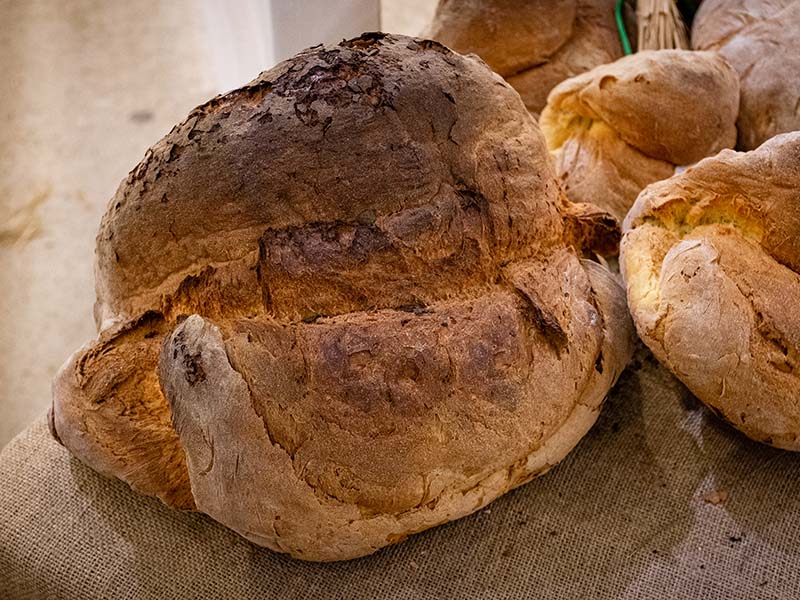
Origin: Apulia region
Pane di Altamura is a leavened bread delicacy from the Altamura area also in Bari, Apulia. It is one of the few Italian breads that enjoy the EU-granted DOP (Protected Designation of Origin) status. That means any bread produced outside Altamura that uses that name is fake.
Authentic Pane di Altamura has to be made from local durum wheat and water with the traditional method. This yellow, bold-flavored, crisp-crusted bread is as hardy as its makers, capable of staying fresh for amazingly up to two weeks without any preservatives.
You can learn everything there is to know about Pane di Altamura here.
19. Pane Toscano
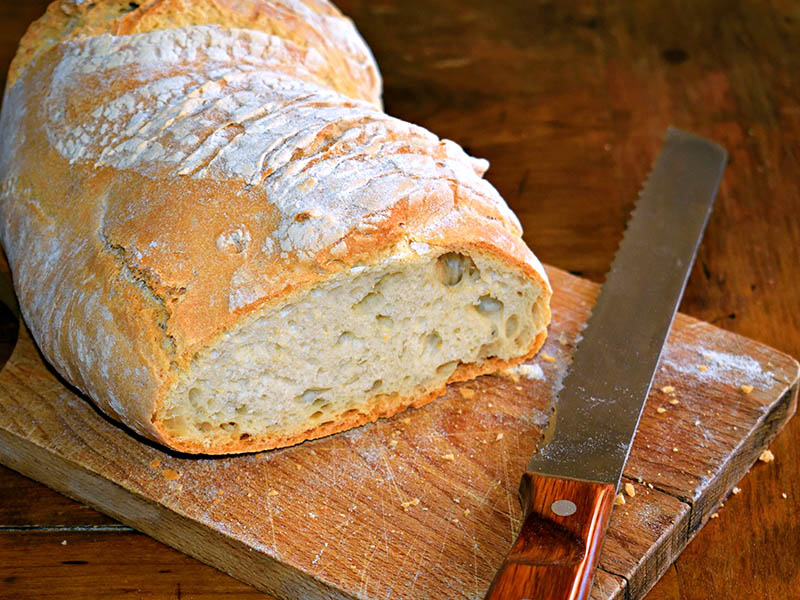
Origin: Tuscany region
In case you don’t speak Italian, Pane Toscano means “Tuscan bread”. But this curious piece of Italian baked goods is not only well-liked in Tuscany but also in nearby Umbria and Marche.
I say “curious” because Pane Toscano is famous for containing no salt at all, resulting in a totally bland taste. Its crust is also paler in color and drier, crispier in texture.
It is very similar to Pane Altopascio, another saltless bread from Tuscany or, more precisely, from the city of Lucca.
Due to its tastelessness, Pane Toscano must be paired with flavorful Italian recipes or dishes like cured hams or cheese. Many people speculate that a severe salt shortage during the Middle Ages forced the inhabitants to create this bread with surprisingly lasting fame.
20. Buccellato di Lucca
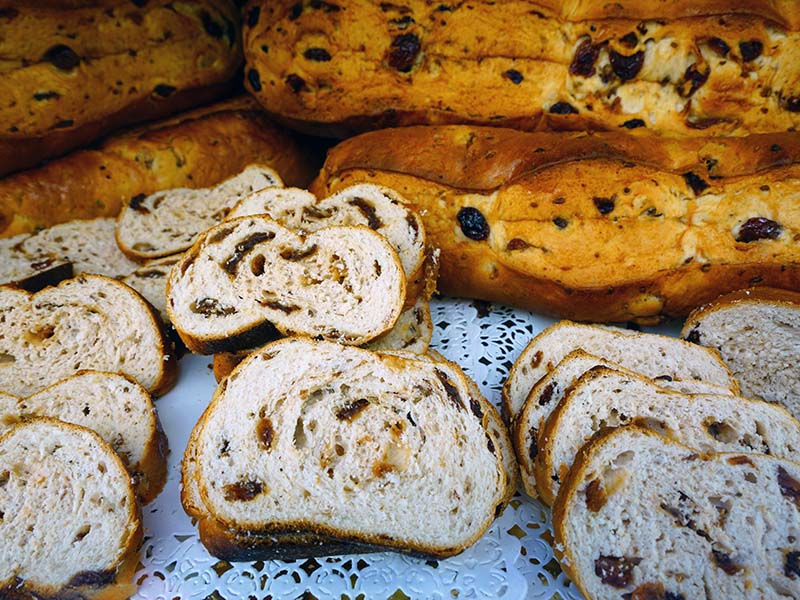
Origin: Tuscany region
People with a sweet tooth would probably grimace at the tasteless Pane Altopascio. Don’t worry because the city of Lucca boasts a fabulous treat that will light up their faces. It is a sweet bread called Buccellato di Lucca.
According to some sources, local confectioners started preparing it for their affluent customers in the mid-15th century. The original function of Buccellato was to serve church confirmation ceremonies. Nowadays, it is a well-liked treat for any occasion of the year.
An amazing characteristic of Buccellato is that it’s always served fresh on the day it’s out of the oven. Quickly purchase this ring-shaped, brown cake and savor its soft, aniseed-flavored crumb. You can also munch on the richly sweet raisins that Buccellato is overflowing with.
21. Piadina Romagnola
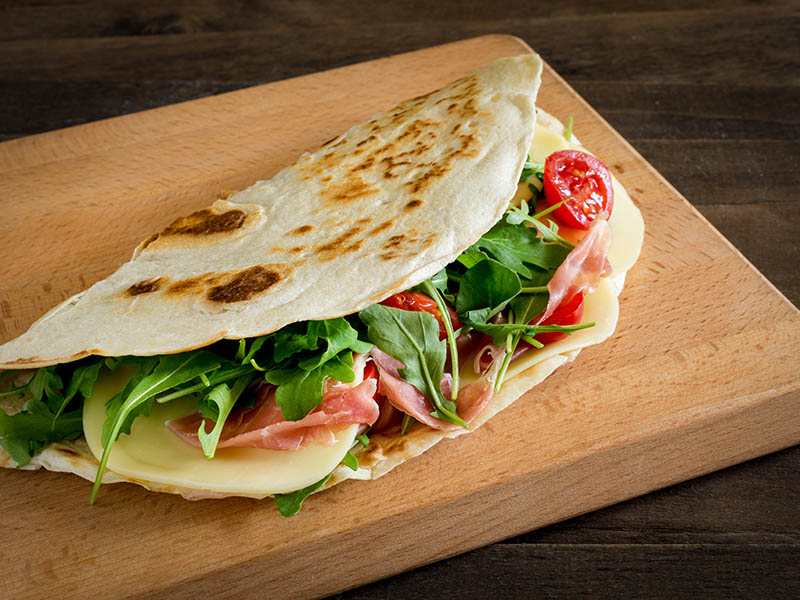
Origin: Emilia-Romagna region
When you visit northern Italy and want a finger-licking Italian sandwich, set your sights on Piadina Romagnola. Despite starting as food for the impoverished peasants of Emilia-Romagna, it has become a preferred flatbread treat for locals.
One theory suggests that the name Piadina has its root in the Greek word for Focaccia. If so, that is interesting because those two breads share very few similarities. Piadina is an unleavened flatbread that people cook in flat pans or electric griddles these days.
When strolling through local street food stalls, you will be greeted with the ubiquitous sight of Piadina sandwiches. Can you walk away from pork lard or olive oil-fried Piadina stuffed with savory cured meats, cheeses, and veggies?
Piadina Romagnola is a simple, rustic flatbread. However, don’t judge this bread at its face value. This widely recognized Emilia-Romagna specialty is the owner of the prestigious PGI (Protected Geographical Indication) status.
Check out this recipe if you care for a finger-licking serving of stuffed Piadina Romagnola.
22. Crescentina Modenese

Origin: Emilia-Romagna region
Many people remember the province of Modena in the Emilia-Romagna region for its balsamic vinegar and fine cheese. But this land also possesses another culinary delight in the form of Crescentina Modenese, a small round bread.
Crescentina Modenese is also known as Tigelle. At first glance, it bears a strong resemblance to the well-known Piadina. In fact, both types of bread have the same ingredients. But the former is thinner and much smaller than the latter.
In addition, the Modena-style version is always accompanied by a pork lard-based spread called Cunza, as well as nutty Italian cheese, jams, and cold cuts. Other areas in Emilia-Romagna, such as Bologne, Ferrara, or Parma, also boast their own version of Crescentina.
23. Coppia Ferrarese

Origin: Emilia-Romagna region
There are many astonishing things about Coppia Ferrarese. Firstly, it is a PGI product, which means it can only be produced in Ferrara. And secondly, it’s got an eye-catching shape resulting from two strands of dough twisted together into an X shape.
That’s how this delicacy acquired the name Coppia (“coupling” in Italian). It is essentially a golden sourdough bread made from soft wheat flour, pure pork lard, and olive oil. With such ingredients, imagining its rich, nutty, and fatty sweetness is no difficult task.
Breadmaking has been present in Ferrara since the late 13th century, while Coppia Ferrarese first appeared in 1536 at least. It has played an important role in the culture and cuisine of Ferrara ever since.
Discover everything you want to know about Coppia Ferrarese here.
24. Pane Pugliese
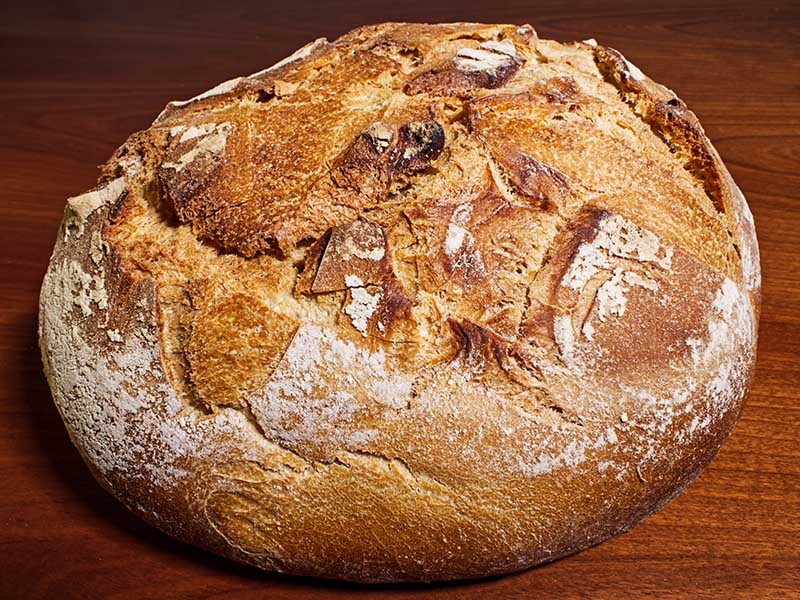
Origin: Apulia region
From the 15th to the early 16th centuries, northeastern Italy was subject to invasions from the mighty Ottoman Empire. Although the great Islamic power didn’t hold its Italian territory for long, the Turks managed to influence the cuisine of this land, like the case with Pane Pugliese.
This Apulian specialty first emerged in the 15th century, modeled after the rustic brown bread belonging to the Turks who ruled the south of Italy at that time. Pane Pugliese was a poor man’s food for most of its existence, but its status is currently improving.
This bread is made from durum wheat, water, and yeast. The ingredient list may sound simple, but local bakers put a lot of effort into preparing, fermenting, and kneading the dough.
The ultimate goal is to create a beautiful pale gold loaf with a crunchy crust and an airy, sweet interior. This bread is now a must-try when you visit Apulia.
25. Baba Rustico
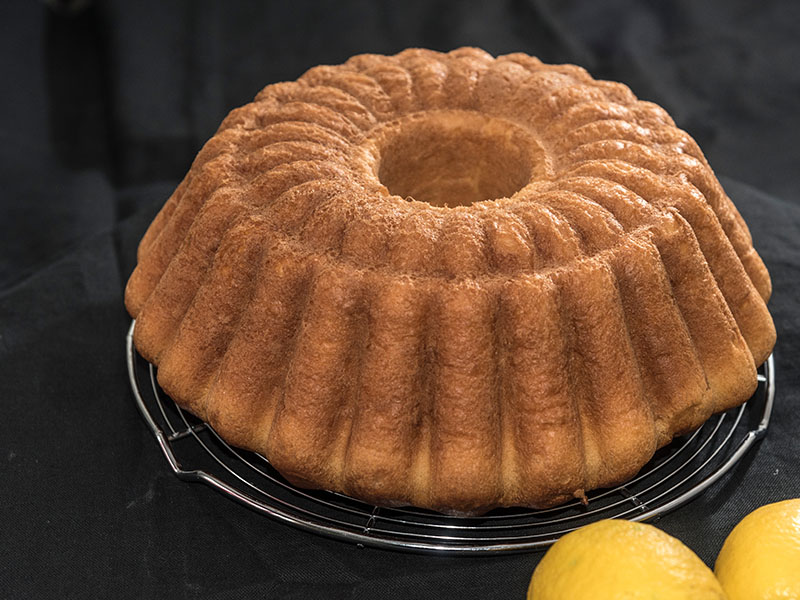
Origin: Campania region
Anyone looking for yummy Italian pies and cakes will be pleased with Baba Rustico. It is a cornerstone of the Neapolitan dessert menu, usually prepared for big holidays, birthday parties, and other joyous occasions.
This savory bread owes its scrumptiousness to the various rich ingredients hidden behind its fluffy, sweet dough. They are Salami (cured sausage), Prosciutto Cotto (cooked ham), and, of course, delectable Italian cheese such as parmesan or scamorza.
Baba Rustico may look like Pandoro from certain angles, except that it is a multiple-pointed star, not just 8. It is also shorter, more golden in color, and has a meatier taste. You can go to Naples and Sorrento to experience this bundt-like delight.
26. Torta al Testo
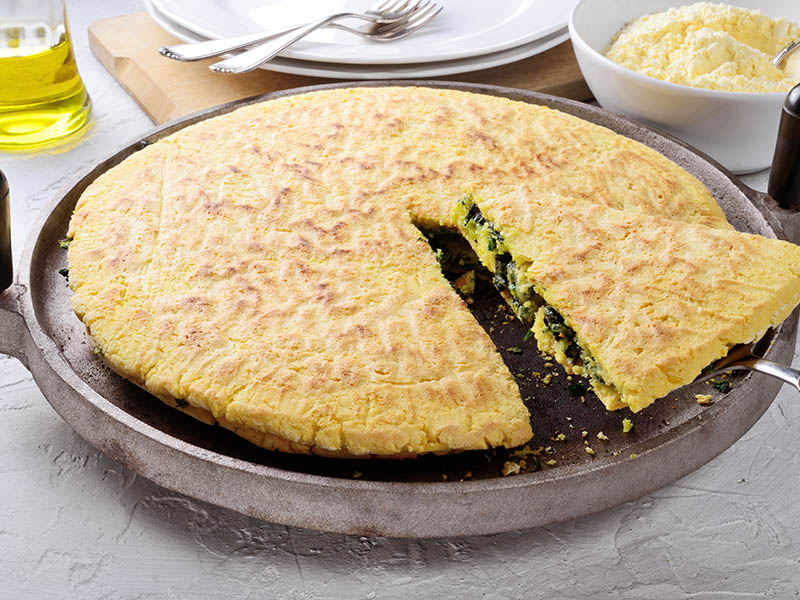
Origin: Umbria region
Torta al Testo is an unleavened delicacy from the Umbria region in central Italy. “Torta” is the Italian word for “cake”, while Testo is the circular cast iron pan in which people cook the bread. Fresh Torta al Testo wrapped around cured meat and cheese is a delightful yet fulfilling snack.
There are numerous recipes for this flatbread throughout Umbria. But they all involve different ways of transforming flour, salt, olive oil, and, sometimes, herbs into crisp and nutty flatbreads. Some bakers even add leavening agents such as baking soda to the dough.
Curiously, many people occasionally call Torta al Testo by the name of Crescia, a fluffy Easter cheese bread also from Umbria. Although Torta al Testo is part of multiple Easter parties in the region, it can be enjoyed year-round, unlike Crescia.
What is the best place to enjoy Torta al Testo? A restaurant in Umbria, of course.
27. Brioche col Tuppo
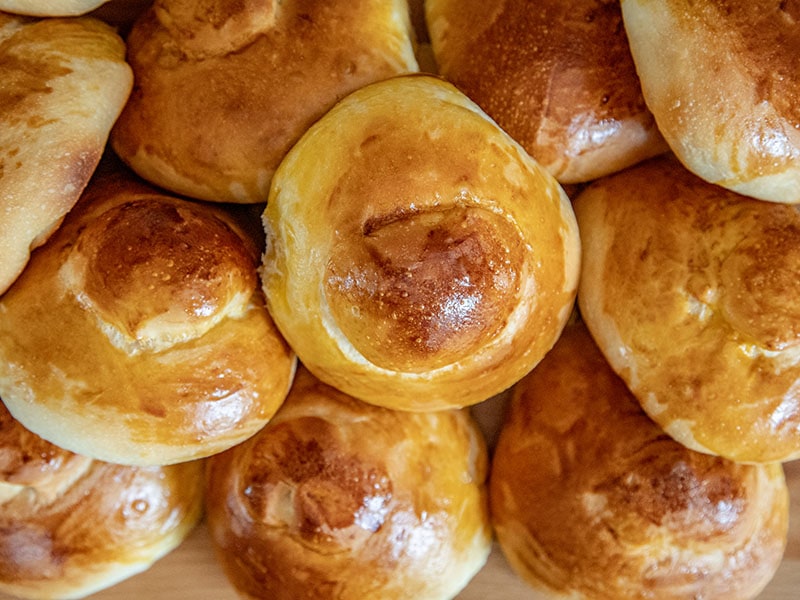
Origin: Sicily region
Don’t say no to Brioche col Tuppo if you are a fan of Sicilian foods. I’m not sure when this Italian version of Brioche first appeared, but certainly not long after the original recipe was formally created in the 17th century.
In many aspects, Brioche col Tuppo is strongly similar to its precursor. Thanks to the liberal amount of egg, honey, and butter, it is golden brown, soft, and fragrant.
However, this Sicilian version comes with a small round top bun (tuppo) that you have to remove before eating. Aside from using it with coffee as a regular morning meal in Italy, you can enjoy this Brioche with flavored Granita or cut the cake in half and fill it with Gelato.
28. Pane Carasau
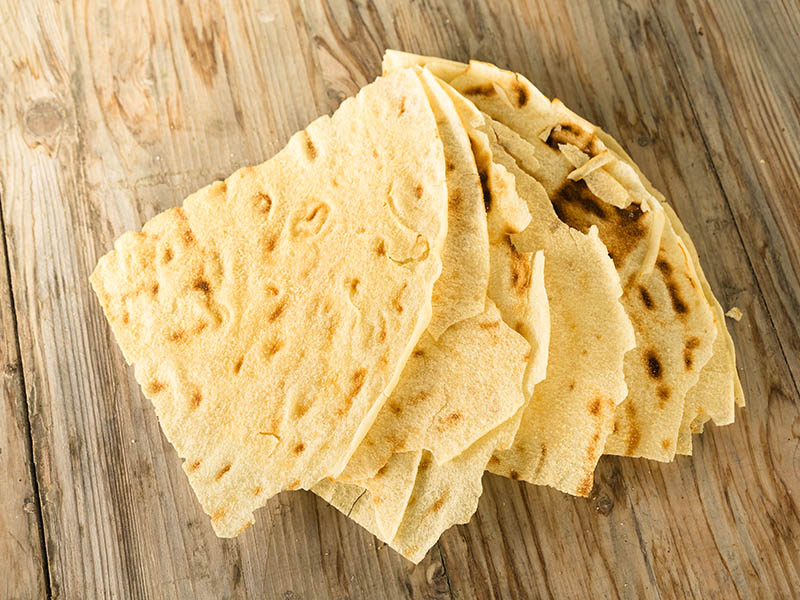
Origin: Sardinia region
Since you’re obviously not fed up with Italian flatbread yet, let’s have a bite of the Sardinian specialty Pane Carasau. This bread is made from yeast-leavened durum wheat flour and salt and is very thin and deliciously crisp.
The secret to the flatbread’s teeth-pleasing crunchiness is that it is double-baked until golden. This method also imparts a long shelf life to Pane Carasau, which can last up to a year in ideal conditions. Apparently, shepherds working far from home came up with this recipe.
Italians romantically describe Pane Carasau as “carta da musica” (“music sheet”), claiming that you can read a sheet of music through an uncooked, paper-thin Pane Carasau.
For a less artistic purpose, you can enjoy this flatbread with olive oil, green olive, or Sardinian sausages.
Learn about what makes Pane Carasau special here.
29. Pane Casareccio di Genzano
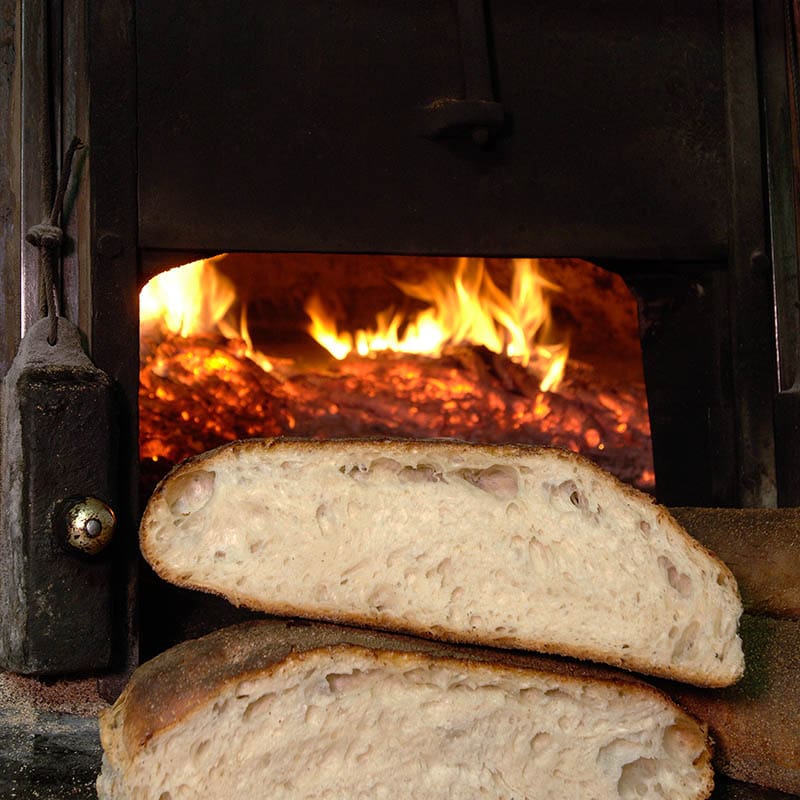
Region: Lazio region
Allow me to introduce this specialty from Genzano, a town south of ancient Rome. It is an IGP-certified country bread, meaning Genzano is the only place you can reliably find it. Even its name “Pane Casareccio”, which means something like “homemade bread”, says so.
So, where does all the fuss about this bread come from? Perhaps it’s the fact that Genzano has produced this bread uninterrupted for more than three centuries. It can also be that Genzano bread requires premier local flour, wheat bran, natural yeast, and salt to be at its best.
Pane Casareccio di Genzano is renowned for having a tender, ivory-white crumb and a sturdy crust accompanied by a subtle woody, smoky fragrance. A loaf of this dark brown, rough delight will bring out the best flavor in your soups, stews, and sauces.
30. Vastedda

Origin: Sicily region
One of themost sensational dishes you can try in Sicily is Pani Câ Meusa, a veal spleen sandwich! This delicacy derives its exciting taste not only from the fatty spleen but also from Vastedda, a traditional Sicilian bread.
The region’s capital Palermo is the best place to find Vastedda. This golden-brown bread has the shape of a burger or large donut, along with a thick crust. It has a spongy inside that is easy to split and stuff with spleen and Ricotta cheese to create an outlandish sandwich.
31. Muffuletta

Origin: Sicily region
Muffuletta is a round Sicilian yeast-leavened bread that is sprinkled with toasted sesame seeds. This oil-rich spice gives Muffuletta a crunchy, tongue-pleasing bite while complimenting the bread’s soft, white crumb. Muffuletta usually comes in a big size.
Countless foods can accompany this Sicilian specialty. But Italian immigrants created the most famous Muffuletta combo in New Orleans, America, in 1906.
Simply split a loaf in half and fill it with olive salad, salami, hams, and Italian cheese. Now, you have a fantastic cold sandwich to enjoy.
See how Americans increase the value of Italian Muffuletta with this recipe.
32. Bisciola
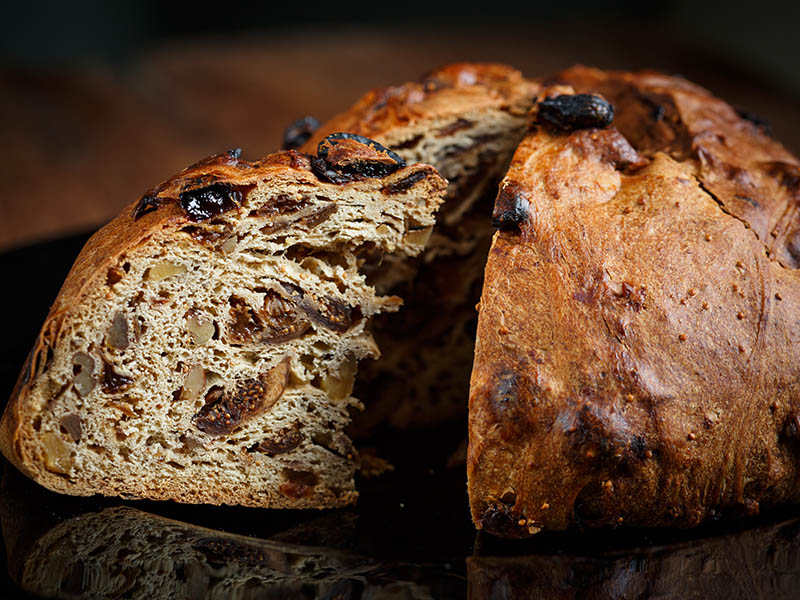
Origin: Lombardy region
Like in other countries, Christmas is the time when all foodie heaven let loose in Italy. One of the most ubiquitous treats you will run into during that time is the sweet leavened bread Bisciola. It is a contribution from the alpine Valtellina Valley in Lombardy.
According to the anecdote, one of Napoleon’s cooks devised this bread at his request during the commander’s Italian campaign. Today, people still prepare Bisciola from the same ingredients as the old chef did: buckwheat flour, dried figs, honey, nuts, among other things.
Behind this bread’s dark and rough exterior is the firm and tasty ivory-colored crumb. You can leisurely chew on the sweet raisins and take in the pleasant rustic aroma resulting from completely natural ingredients.
33. Biscotti

Origin: Tuscany region
Beware of Biscotti, or you will suffer from its curse. Many people lament that this Italian almond biscuit is so tasty that they can’t stop enjoying it. This temptation had existed in Italy for a long time before a chef living in the Tuscan city of Prato perfected the recipe around the 19th century.
If you look for this dry and crunchy delight in Prato, remember to use the local name Cantuccini. Say that magic word, and vendors will show you this golden, doubled-baked, oblong-shaped, and almond-studded biscuit.
For your information, Biscotti is an Italian generic name for any cookie that is baked twice. Italians usually say “Biscotti di Prato” when they want to clearly signify this variety, which they often enjoy as a dessert after dinner.
34. Farinata

Origin: Liguria and Tuscany regions
Also known as Corta di Ceci or Cecina, this thin and unleavened pancake is quite different from other breads since it consists of chickpea flour. Legend has it that some Roman soldiers accidentally created this bread when they roasted chickpea flour on their shield.
Have a taste of Farinata, and you can savor the nutty sweetness of chickpea, the herbal fragrance of rosemary, and the richness of olive oil. This pancake is slightly crispy on the outside but pleasantly custardy in the middle.
Farinata originated in the populous city of Genoa before spreading to other corners of Italy and the world. People love to enjoy it with succulent seafood and fresh veggies, from Europe’s Gibraltar to many Latin American countries.
Making Farinata will be quite easy once you follow this detailed guide.
35. Strazzata
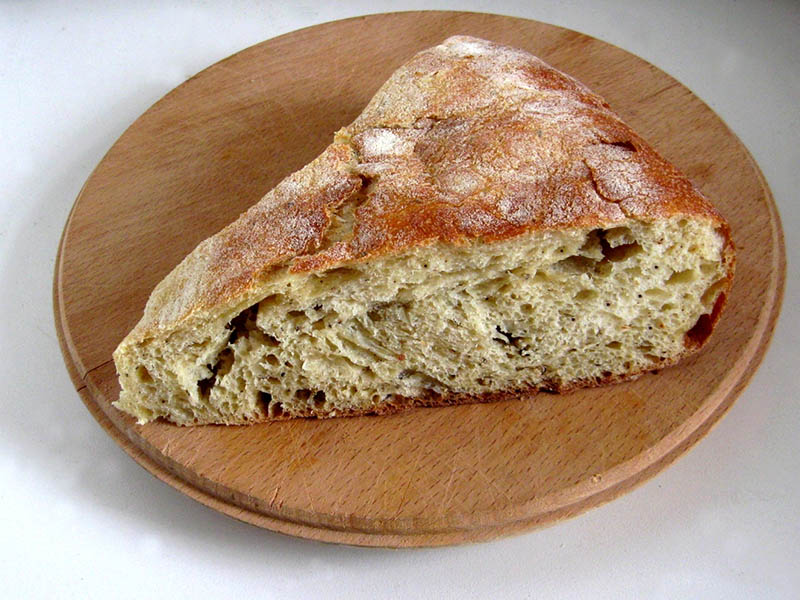
Origin: Basilicata region
While the village of Avigliano in southern Italy is charming, it may not have been as famous had it not been the birthplace of the tasty bread Strazzata. This specialty is essentially a variant of the national delight Focaccia. In the past, it was a must-have at many important feasts.
This round bread has a hole in the center, making it easier to hold. Its taste is much more diverse than regular Focaccia, for including oregano, pork lard, and bacon in the ingredient list. You can enjoy it alone or serve it lavishly with cheese, cold meat, and stews.
36. Torta delle Rose
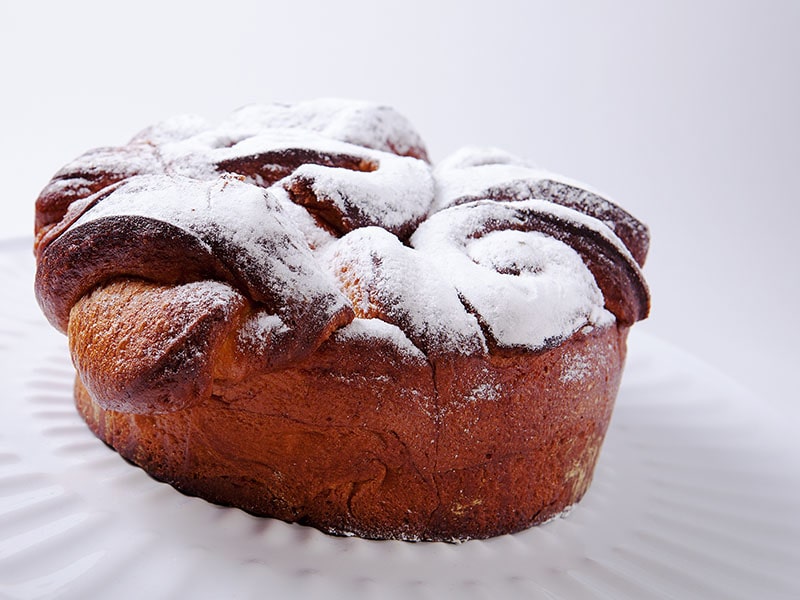
Origin: Lombardy region
Torta delle Rose has a fascinating fruity fragrance and a buttercream sweetness as mouth-watering as honey. But what really makes it stand out from the crowd is its lovely rose-shaped appearance. Can real roses please your taste buds like those?
Unsurprisingly, Torta delle Rose is a vital part of Italian wedding celebrations. By some accounts, it was created as a Lombard tribute to a noblewoman’s wedding in 1490. The beautiful rosebuds were symbolic of the bride’s beauty, a meaning that is still relevant these days.
37. Gnocco Fritto
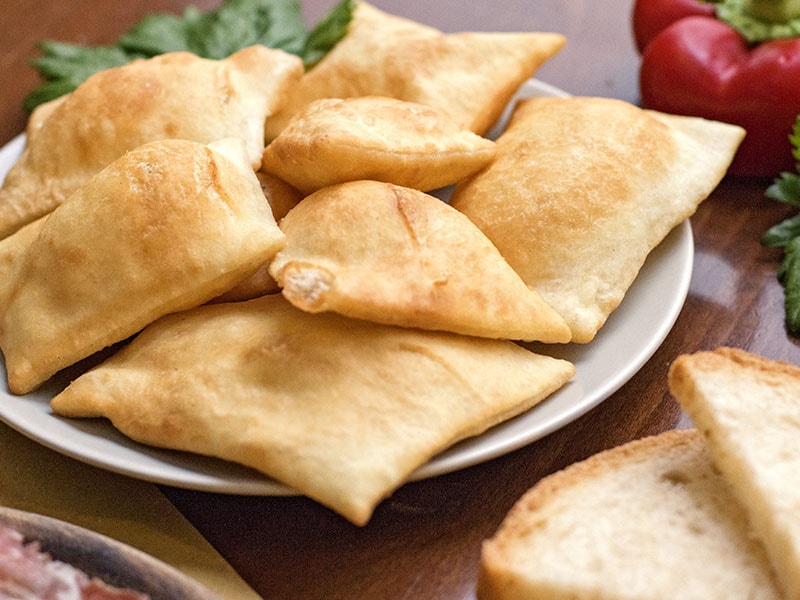
Origin: Emilia Romagna region
Gnocco Fritto is a variety of Crescentina from Emilia Romagna. But you will hardly find any similarity between it and Crescentina Modenese. While the latter is a round bread and can be made into a sandwich, Gnocco Fritto is a diamond-shaped fluffy fried bread.
To be more specific, Italians deep-fry the dough in oil until the bread turns golden and puffs up beautifully. The traditional options to pair with Gnocco Fritto are Mortadella (Italian sausage), cured meat, and cheese. Those combos are wonderful both as appetizers and full meals.
Check out this incredibly easy recipe for making Gnocco Fritto at home.
38. Pane di Laterza

Origin: Apulia region
By now, you can reasonably guess that Pane di Laterza comes from someplace called Laterza, but where? That is a town in the Apulia region of southeastern Italy. Its traditional bread is now one of the country’s most cherished delicacies.
Pane di Laterza is usually available in large chunks weighing between two and four kilograms. This durum flour-based sourdough bread boasts a special aroma thanks to being baked with olive wood along with buttery nuts such as apricot and almonds.
With a history of many centuries, Pane di Laterza totally deserves your attention when you crave Italian foods. Just bite off a piece of its crisp brown crust and sink your teeth into its milky white, incredibly soft yet rich crumb.
39. Penia
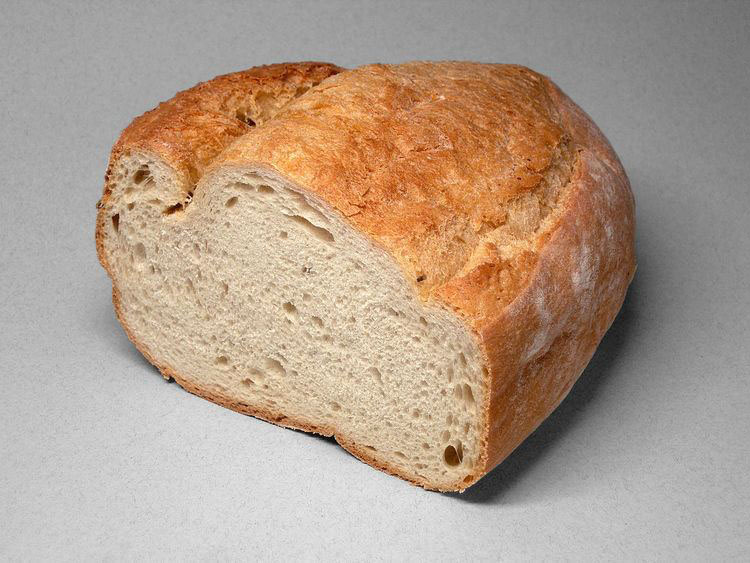
Origin: Italy
Penia is one of the unfortunately underrated Easter treats in Italy. You won’t have much luck finding it in big bustling cities. Instead, head to the countryside, especially when Easter is close, to try this delight. Penia looks just like other breads, so keep your eyes peeled for it.
Among the many ingredients that constitute Penia are anise seeds and lemon. Those two things give it a tangy bite followed by a herbal, citrusy sweetness that will send your saliva production into overdrive. Penia is delicious enough on its own, but adding some jam won’t hurt.
40. Tortano
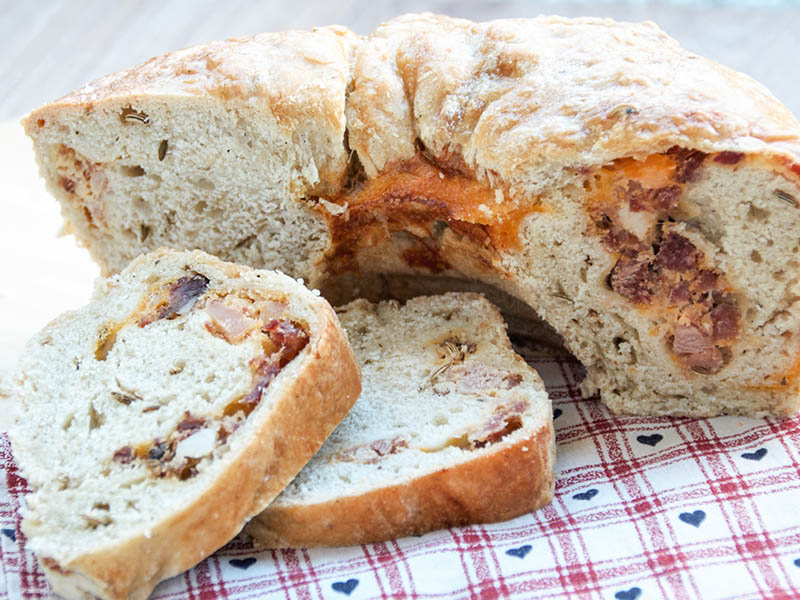
Origin: Campania region
Here is another finger-licking Easter bread from Italy. It is more well-known than Penia, perhaps because Tortano is a specialty of beautiful Naples. Enjoying this treat while you are visiting the area’s picturesque towns and dramatic coastline is quite awesome.
Many people call Tortano the “Royal Crown” for a good reason. This crusty, dusky bread has the shape of a crown with a hole in the middle. When your teeth get to the soft, pearly white inside, your taste buds will be greeted with the savory richness of eggs, ham, and cheese.
41. Sgabeo
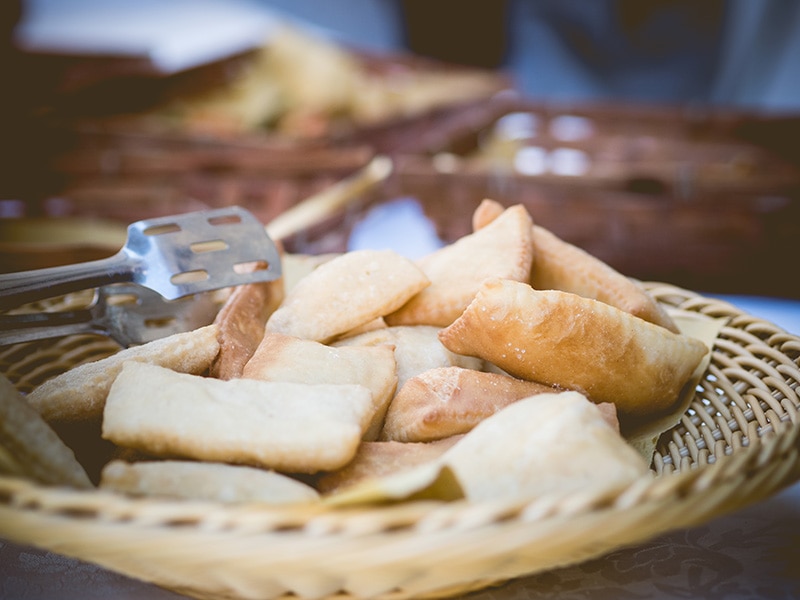
Origin: Liguria and Tuscany regions
The Lunigiana region is no more as it was divided between nearby Liguria and Tuscany regions. But its traditional bread Sgabeo lives on and continues to provide Italians with tons of culinary pleasure.
Sgabeo was formerly made from corn flour for poor people. But the modern recipe uses leavened bread dough. Cooks cut it into strips and fry them until crisp and slightly golden. Sprinkled with some salt, you have a tasty dish to accompany your Italian meal.
When you want to improve the flavor of Sgabeo, feel free to pair it with cheese and cold cuts. However, in food stalls or roadside restaurants, you can also find a combination of cream or chocolate.
When In Rome, Enjoy Bread As Romans Do
Since the age that Roman emperors reigned over their vast domains, bread has been Italy’s staple food. That long history and the country’s abundance of natural gifts result in a wide array of Italian breads. Whatever your heart yearns for, you can always fulfill your craving in Italy.
So which one is your favorite? Is it sweet bread for snacks and desserts like Pandoro? Or does the tasteless Pane Toscano attract your attention? Before you turn to the ubiquitous Focaccia, remember every Italian region has its own varieties that you should explore and experience.
Don’t forget to tell your friends about this post if you find it helpful. The comment section is welcome to any idea that you care to share. I hope you will have a whale of a time with Italian breads. See you soon!
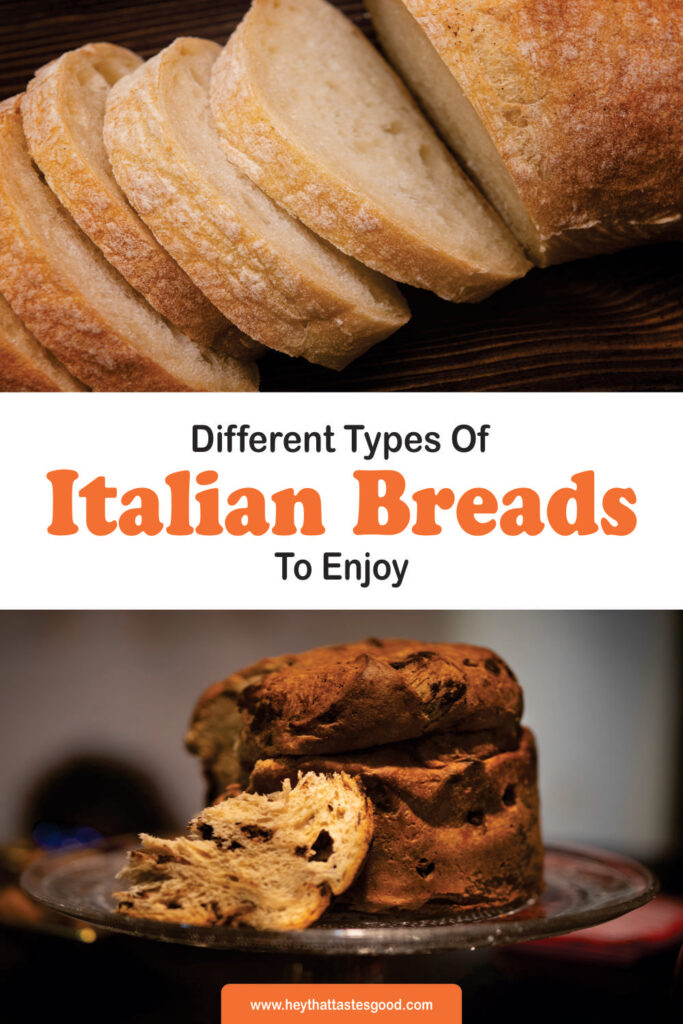


Linda Dean
Expertise
Culinary Arts, Food Journalism, Global Cuisine, Exploration, Recipe Development, Cultural Food Studies, Culinary Travel and Storytelling
Education
Culinary Institute of America, Hyde Park, NY
Program: Associate in Culinary Arts
Focus: Developed a comprehensive understanding of global cuisines and essential cooking techniques. Engaged in intensive hands-on practice in both kitchens and real-world settings, guided by expert chefs. This program emphasized the application of culinary skills in professional environments, preparing students for a variety of roles in the culinary industry.
City, University of London, London, UK
Program: BA Journalism
Focus: Gained expertise in media studies with a strong foundation in reporting, editing, and communicating. While the program focuses broadly on journalism, the skills acquired apply to food journalism, including the ability to analyze and report on food culture and culinary trends effectively.
Linda Dean is an experienced chef and food writer who loves exploring flavors from around the world. Trained at the Culinary Institute of America, Linda has spent over ten years mastering the art of making dishes that truly represent different cultures. She also studied journalism at City, University of London, which helps her write engaging stories about these foods.
On heythattastesgood.com, Linda shares recipes that bring the world’s kitchens to her readers. She focuses on authentic tastes and the stories behind them, making it easy for anyone to try international cuisine at home.